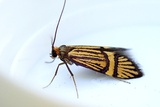Nemophora congruella (Zeller, 1839) Species
Last modified: March 22, 2025, 10:02 a.m.
A very rare and local species in Belgium, only known from LG.
Details
- Classification
- Family: Adelidae > Subfamily: Adelinae > Genus: Nemophora > Species: Nemophora congruella
- Vernacular names
- Geaderde langsprietmot (NL), Gelbschwarzer Nadelwald-Langhornfalter (DE)
- First mention in Belgium
- Janmoulle E. 1954a. Espèces nouvelles pour la faune belge (suite). — Lambillionea 54: 3–4, 33–34, 57–58. On page 4.
- Status
-
Native
Distribution
Imago
Wingspan 15–17 mm. Antenna in males 2,5 times the wing length. The thorax is shining bronzy golden coloured. The dominant colour of the forewings is shiny golden yellow-orange, with longitudinal violet-black streaks. Forewings have a broad transversal yellow fascia across the entire wing's width at about 2/3 of the forewing length. This central band is bordered by two lead-grey bands with a black border. These two bands are nearly as broad as the central yellow part. The basal part of the wings has three longitudinal lead-grey, bluish-violet shining stripes reaching the transversal fascia. Hind wings are brownish-grey.
Can be confused with N. degeerella but the latter has a darker dominant forewing ground colour. The forewing fascia in N. congruella is located closer to the base and the forewings markings are bright yellow instead of almost leather-brown. The central transversal fascia is more straight.
Caterpillar
The larva lives in an arched case of needles.
Case
Up to 10 mm long. The flattened case is parallel-sided. It is the only case in this genus where pine needles are arranged across the case.
Bionomics
The larvae were found among detritus at the feet of Picea abies and Abies alba. They are fully grown in late summer and pupate during wintertime. Adults fly during the daytime and at dusk. Males have occasionally been observed at light during the night.
Flight periods
Adults can be seen from mid-May towards mid-July.
Observed on
- Host plant (species):
- Picea abies
The larva feeds on fallen needles of Picea abies and on general detritus.
Habitat
Cool, shadowy pine forests with a lot of Abies alba and other pine trees.

